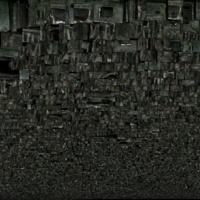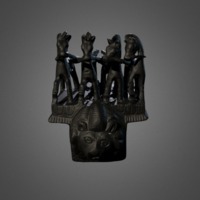Figura de bronze da carruagem romana - Bronze Roman chariot figure
Dublin Core
Title
Figura de bronze da carruagem romana - Bronze Roman chariot figure
Subject
CULTURAL HERITAGE
Description
Peça formada por uma quadriga estacionária de cavalos ligados pelas rédeas. Assenta numa plataforma quadrangular com abas com rebordo em três dos lados. Esta está sobre uma base de forma cúbica, oca. Os cavalos têm corpo alongado, pernas hirtas, afastadas umas das outras, e a cauda é bastante espessa, curta e levantada. Mantêm a cabeça inclinada para o centro, parecendo controlados pelo auriga que puxa as rédeas para os suster. Apresentam uma alta crina, que avança para a testa, e duas orelhas arrebitadas. Os olhos são salientes e a boca não está marcada mas encoberta pelas rédeas. A face do cubo voltada para a frente é preenchida, quase na sua totalidade, por uma cabeça de leão que se prolonga pela aba da plataforma. O leão tem uma farta juba, olhos bem assinalados, pequenas orelhas, nariz achatado e uma boca aberta com dois orifícios laterais, donde podia pender uma argola. As arestas são decoradas por incisões em semicírculos irregulares, com um sulco diametralmente colocado, com intenção provável de esquematizar a folhagem. A mesma ornamentação, um pouco ampliada, é utilizada na aba pendente da plataforma; o rebordo desta é recortado por pequenos sulcos paralelos e verticais. De ambos os lados da caixa de inserção, na zona posterior superior dois orifícios, para cravejar a peça à haste de madeira que a suportava.
Piece formed by a stationary quadriga of horses connected by the reins. It rests on a quadrangular platform with flaps with flange on three sides. This is on a hollow cubic base. The horses have an elongated body, straight legs, apart from each other, and the tail is quite thick, short and raised. They keep their heads tilted towards the center, seeming to be controlled by the charioteer who pulls the reins to sustain them. They have a high mane, which advances to the forehead, and two protruding ears. The eyes are prominent and the mouth is not marked but covered by the reins. The face of the cube facing forward is filled, almost in its entirety, by a lion's head that extends over the flap of the platform. The lion has a large mane, well-marked eyes, small ears, a flat nose and an open mouth with two side holes, from which a ring could hang. The edges are decorated by incisions in irregular semicircles, with a groove diametrically placed, with the probable intention of schematizing the foliage. The same ornamentation, slightly enlarged, is used on the platform's pendant flap; its edge is cut by small parallel and vertical grooves. On both sides of the insertion box, in the upper rear area, two holes, to secure the piece to the wooden rod that supported it.
Format
text/plain Alias/WaveFront Object
Type
3D Object
Spatial Coverage
current,38.697271,-9.207835;
License
Creative Commons Attribution-NonCommercial-ShareAlike License
Europeana
Object
https://sketchfab.com/models/74b88af1f905461b9495a47bca1a74df/embed
Europeana Type
3D
3D Object Item Type Metadata
Wiki
https://eu-lac.org/vmwiki/index.php/Figura_de_bronze_da_carruagem_romana_-_Bronze_Roman_chariot_figure
DescriptionEN
Peça formada por uma quadriga estacionária de cavalos ligados pelas rédeas. Assenta numa plataforma quadrangular com abas com rebordo em três dos lados. Esta está sobre uma base de forma cúbica, oca. Os cavalos têm corpo alongado, pernas hirtas, afastadas umas das outras, e a cauda é bastante espessa, curta e levantada. Mantêm a cabeça inclinada para o centro, parecendo controlados pelo auriga que puxa as rédeas para os suster. Apresentam uma alta crina, que avança para a testa, e duas orelhas arrebitadas. Os olhos são salientes e a boca não está marcada mas encoberta pelas rédeas. A face do cubo voltada para a frente é preenchida, quase na sua totalidade, por uma cabeça de leão que se prolonga pela aba da plataforma. O leão tem uma farta juba, olhos bem assinalados, pequenas orelhas, nariz achatado e uma boca aberta com dois orifícios laterais, donde podia pender uma argola. As arestas são decoradas por incisões em semicírculos irregulares, com um sulco diametralmente colocado, com intenção provável de esquematizar a folhagem. A mesma ornamentação, um pouco ampliada, é utilizada na aba pendente da plataforma; o rebordo desta é recortado por pequenos sulcos paralelos e verticais. De ambos os lados da caixa de inserção, na zona posterior superior dois orifícios, para cravejar a peça à haste de madeira que a suportava.
Piece formed by a stationary quadriga of horses connected by the reins. It rests on a quadrangular platform with flaps with flange on three sides. This is on a hollow cubic base. The horses have an elongated body, straight legs, apart from each other, and the tail is quite thick, short and raised. They keep their heads tilted towards the center, seeming to be controlled by the charioteer who pulls the reins to sustain them. They have a high mane, which advances to the forehead, and two protruding ears. The eyes are prominent and the mouth is not marked but covered by the reins. The face of the cube facing forward is filled, almost in its entirety, by a lion's head that extends over the flap of the platform. The lion has a large mane, well-marked eyes, small ears, a flat nose and an open mouth with two side holes, from which a ring could hang. The edges are decorated by incisions in irregular semicircles, with a groove diametrically placed, with the probable intention of schematizing the foliage. The same ornamentation, slightly enlarged, is used on the platform's pendant flap; its edge is cut by small parallel and vertical grooves. On both sides of the insertion box, in the upper rear area, two holes, to secure the piece to the wooden rod that supported it.
Files
Collection
Citation
“Figura de bronze da carruagem romana - Bronze Roman chariot figure,” EU-LAC, accessed December 27, 2025, https://eu-lac.org/omeka/items/show/220.
Embed
Copy the code below into your web page


